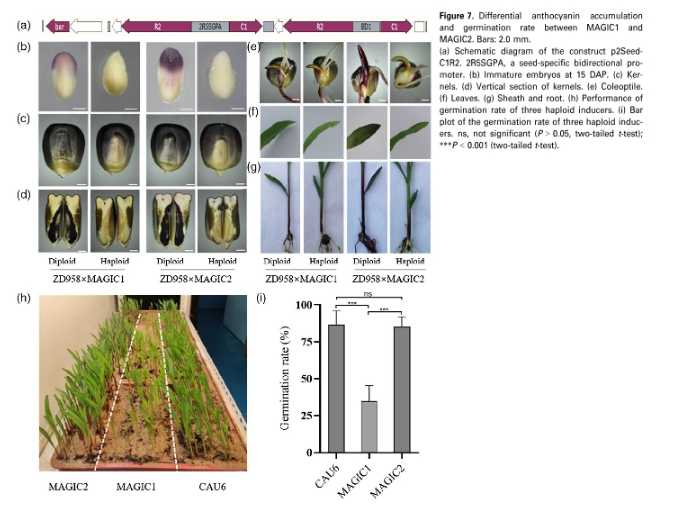Abstract:
Because of their high efficiency during chromosome doubling, immature haploid maize (Zea mays L.) embryos are useful for doubled haploid production. The R1-nj marker is commonly used in doubled haploid breeding and has improved the efficiency of haploid identification. However, its effectiveness is limited by genetic background and environmental factors. We addressed this technical challenge by developing an efficient and accurate haploid embryo identification marker through co-expression of two transcription factor genes (ZmC1 and ZmR2) driven by the embryo-aleurone-specific bidirectional promoter P-ZmBD1; these factors can activate anthocyanin biosynthesis in the embryo and aleurone layer during early seed development. We developed a new haploid inducer, Maize Anthocyanin Gene InduCer 1 (MAGIC1), by introducing the transgenes into the haploid inducer line CAU6. MAGIC1 could identify haploids at 12 days after pollination, which is nine days earlier than CAU6. Importantly, MAGIC1 increased haploid identification accuracy to 99.1%, compared with 88.3% for CAU6. In addition, MAGIC1 could effectively overcome the inhibition of anthocyanin synthesis in some germplasms. Furthermore, an upgraded anthocyanin marker was developed from ZmC1 and ZmR2 to generate MAGIC2, which could identify haploids from diploids due to differential anthocyanin accumulation in immature embryos, coleoptiles, sheaths, roots, leaves, and dry seeds. This haploid identification system is more efficient and accurate than the conventional R1-nj-based method, and it simplifies the haploid identification process. Therefore, this system provides technical support for large-scale doubled haploid line production.
Keywords:anthocyanin marker;doubled haploid (DH);haploid identification;immature haploid embryos;maize (Zea mays L)
Keywords Plus:ZEA-MAYS;ABSCISIC-ACID;INDUCTION SYSTEM;SEED DORMANCY;GENES;PHOSPHOLIPASE;EXPRESSION;MARKER;ALLELE;GERMINATION



